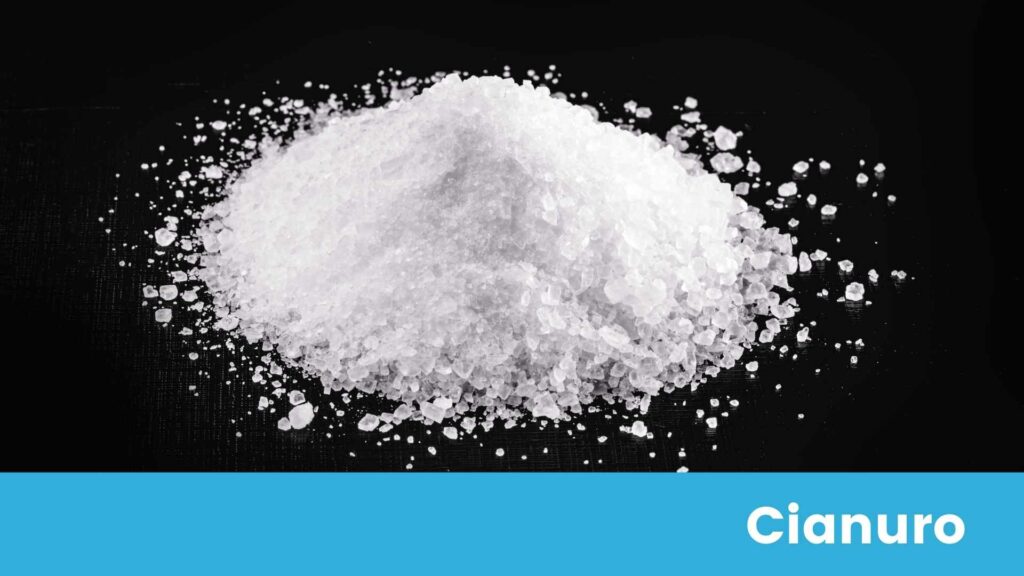What is cyanide?
Cyanide is a representative monovalent anion consisting of a carbon atom and a nitrogen atom joined by a triple bond.
Where is it located?
It is produced by the decomposition of some plants, in fact, it can be present in some foods such as green almonds and cassava, it can also be produced by microorganisms. Cyanide is also used to extract gold and silver from ores.
Types of cyanide
In water it can be measured as free or total cyanide. Free cyanide consists of hydrogen cyanide and cyanide ion, which represent the most toxic forms of cyanide. Cyanide in water can be stably bound to metals such as iron, and total cyanide is the measure of free and metal-bound cyanide in water.
How can you be exposed to this substance?
You can be exposed by breathing air, drinking water, eating food, all from both natural processes and industrial activities. when present in the air, it is usually in the form of gaseous hydrogen cyanide.
One of the main sources of cyanide is cigarettes and it affects people who do not work in industries related to this chemical.
How does it work?
The degree of cyanide poisoning is directly related to the amount to which the person is exposed and the length of time he/she has been exposed. Breathing gas with this component is the most harmful, but ingesting it can also be toxic.
Logically, cyanide gas is more dangerous in places that are closed because it is trapped. This gas evaporates and disperses quickly in open spaces, making it less harmful.
Cyanide gas is less dense than air, so it rises. Cyanide does not allow the body’s cells to use oxygen and this causes the cells to die.
Cyanide is more harmful to the heart and brain than to other organs because they use more oxygen than the others.
Immediate signs and symptoms of cyanide exposure
Anyone who has been exposed to this chemical by ingesting it, breathing it in or absorbing it through the skin may exhibit the following symptoms within minutes:
- Dizziness
- Headache
- Nausea and vomiting
- Fast breathing
- Accelerated heart rate
- Concern
- Weakness
Exposure to large amounts of this chemical by any route can cause these other effects:
- Concussions
- Seizures
- Low blood pressure
- Lung injury
- Slow heart rate
- Fatal respiratory failure
How is cyanide poisoning treated?
Specific antidotes and medical care in a hospital are used. Antidotes for this type of poisoning are most useful if administered as soon as possible after exposure, even before laboratory confirmation.
Cyanide in water
This chemical can be found in industrial wastewater streams that are generated by the extensive production of goods and materials, including refined metals and alloys, leather, paints, pigments, wood preservatives, chemicals and electronic products. Cyanide in wastewater often requires wastewater treatment.
Which technologies are the best to remove it from wastewater?
A variety of technologies are available to treat wastewater and eliminate it. In any separation or treatment solution, the choice of the best cyanide removal technology comes down to suitability for the specific needs required at your facility.
A basic tip we can tell you is to check what cyanide species are present in your waste stream. Cyanide species can be classified into two groups:
Strong dissociable acids (SAD):
They are cyanide compounds in which the cyano group shares a strong bond with a metal such as gold, iron, silver or cobalt. SAD cyanides normally cannot be oxidized or decomposed, and must be removed by physical separation means, such as precipitation or membrane filtration.
Weak dissociable acids (WAD):
They are cyanides that are readily dissociable at neutral pH or below, which include free cyanide anions, hydrogen cyanide and other species where the cyano group shares weak bonds with metals such as copper, nickel, zinc and cadmium. WADs are more toxic and less chemically stable. Canid WADs can normally be decomposed by biological or chemical means to obtain products with less toxicity in a process known as cyanide oxidation or cyanide destruction.
Other factors to consider are also the pH of the stream, temperature, flow rate, volume, current concentration and the target for cyanide use in the stream. It is vital to consider these aspects as only then can we understand what types of wastewater disposal and treatment strategies are best for your facility.
The following are the most common processes for the elimination or reduction of cyanide in wastewater:
Chemical precipitation:
This technology is very popular for separating streams with high SAD cyanide contents. The process consists of metals or metal cations to a wastewater stream, which react with the cyanides present to form new metal-cyanide complexes or precipitates. The precipitated particles can then be removed from the liquid stream by a physical separation process, such as sedimentation or media filtration.
Adsorption:
The adsorption method is widely used in cases where the cyanide concentration is relatively low. Adsorption works by harnessing the forces of molecular attraction to remove all contaminants from a liquid stream. The process consists of passing wastewater through some type of adsorbent medium that serves to attract and retain contaminants.
The advantages of adsorption are its relatively low cost of operation, materials and waste discharge. In addition, in some cases the adsorbed cyanide can be recycled and reused.
Ion exchange:
A physicochemical treatment process in which a liquid stream is passed through a resin substrate that facilitates the exchange of charged ions. The resin used is carefully selected according to the ionic charge of the contaminant(s) to be removed. The resins typically used to remove this chemical are chelating or strong base anion resins.
When the stream enters the column, the resin captures the cyanide anions from the solution, retaining them until the resin regenerates.
Membrane filtration:
A type of physical separation technology that uses a semi-permeable barrier to selectively remove certain contaminants from liquid streams. In membrane separation, the water stream is passed through a porous membrane, usually by applying pressure to the stream. The membrane has precisely sized pores to retain the desired ions, molecules or particles, while allowing the passage of water and other components in the stream.
Facilities typically use reverse osmosis or electrodialysis to remove anions. In some cases, microfiltration or ultrafiltration systems are also used to increase efficiency by pretreatment of the streams prior to reverse osmosis.
Oxidation:
A chemical oxidizer is used to break the carbon-nitrogen triple bond of WAD cyanides. This causes a reaction that forms cyanate, a much less toxic compound that persists less in the environment.
Chemical addition is the most common oxidation method, but other commonly used chemical oxidizers such as hydrogen peroxide, chlorine, oxygen, hypochlorite and sulfur dioxide, etc. are also available. All oxidants are capable of attracting electrons from the anion to form cyanate.









I must show my affection for your kindness supporting men who actually need assistance with this particular area. Your personal commitment to passing the solution up and down appears to be exceptionally useful and have continually encouraged ladies like me to reach their pursuits. This interesting recommendations indicates this much to me and even more to my office workers. With thanks; from all of us.
Hey There. I found your blog using msn. This is a very well written article. I’ll be sure to bookmark it and return to read more of your useful info. Thanks for the post. I’ll definitely return.
I view something truly special in this website .
Wow! This could be one particular of the most helpful blogs We’ve ever arrive across on this subject. Actually Great. I’m also an expert in this topic therefore I can understand your hard work.
I wanted to inform you about how much I actually appreciate every thing you’ve discussed to help increase the value of the lives of individuals in this subject material. Through your own articles, I’ve gone from just a novice to a professional in the area. It’s truly a honor to your efforts. Thanks
very good post, i undoubtedly adore this website, continue it
Love your site. have you got the theme you used that you can share?
I like this site so much, bookmarked .
Hiya, I’m really glad I have found this info. Today bloggers publish only about gossips and internet and this is actually annoying. A good site with interesting content, this is what I need. Thank you for keeping this web-site, I will be visiting it. Do you do newsletters? Can’t find it.
Hello! I simply would want to provide a large thumbs up with the great information you might have here within this post. We are returning to your blog post for further soon.
I actually wanted to make a small note to thank you for those stunning information you are giving at this site. My considerable internet investigation has at the end of the day been paid with reliable insight to exchange with my relatives. I would believe that we site visitors are truly fortunate to dwell in a fabulous network with many brilliant people with insightful suggestions. I feel extremely fortunate to have discovered the weblog and look forward to plenty of more brilliant moments reading here. Thanks a lot again for everything.
You have represented your ideas in an original, interesting and intelligent manner. Your content is great and thought-provoking in my opinion. I agree with your ideas for the most part. Your work is very impressive.
I like this web site very much, Its a real nice spot to read and receive info .
I am glad to be a visitant of this perfect web blog ! , thanks for this rare information! .
I’m impressed, I need to say. Actually, rarely do I encounter a blog that’s both educative and entertaining, and let me inform you, you’ve gotten hit the nail on the head. Your idea is outstanding; the problem is one thing that not enough people are speaking intelligently about. I am very completely happy that I stumbled throughout this in my seek for one thing referring to this.
You ought to be a part of a tournament for one of the highest quality blogs on-line. I am going to suggest this site!
It’s perfect time to make some plans for the future and it’s time to be happy. I’ve read this post and if I could I want to suggest you some interesting things or suggestions. Perhaps you can write next articles referring to this article. I wish to read more things about it!